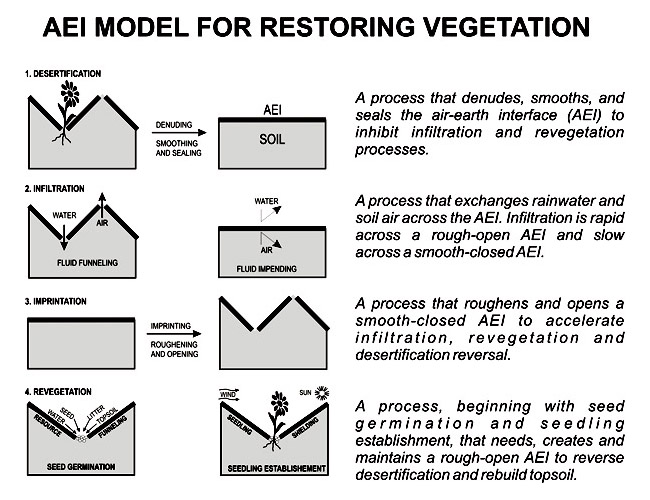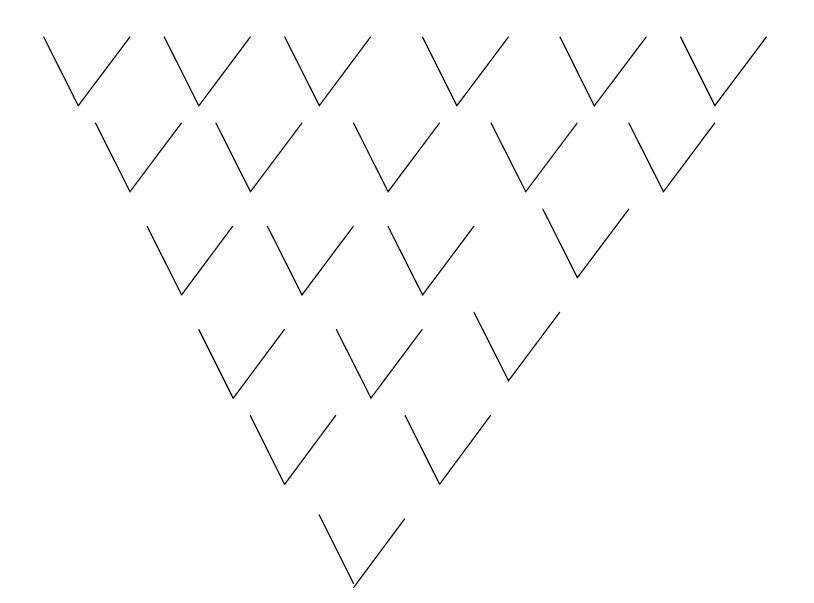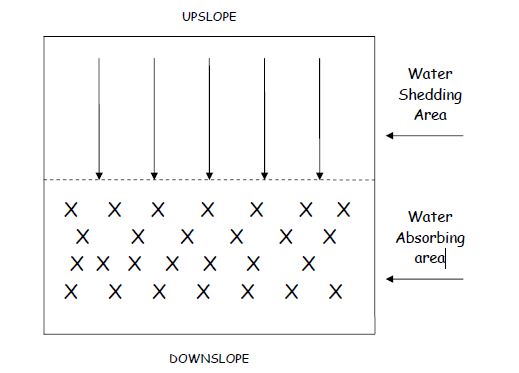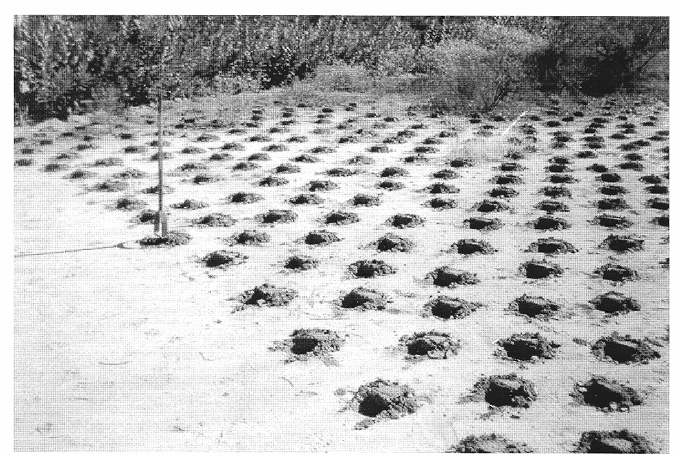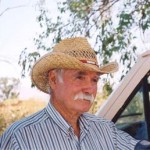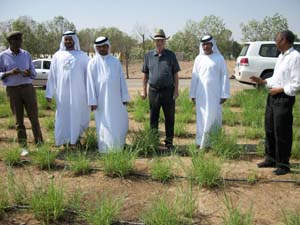September 8, 1996
Robert M. Dixon
ABSTRACT: This paper traces the course of research conducted by the author and several coworkers beginning in 1960 and continuing to the present time. The vast amount of literature on infiltration reveals that field studies often stress the importance of surface conditions, whereas laboratory studies using soil columns suggest that profile properties determine infiltration rates. Our field research concluded that two physical properties of the soil surface–microroughness and macroporosity–interact to control the infiltration rates of an initially dry soil. This finding led to the formulation of the Air-Earth Interface (AEI) Concept of infiltration which states that the microroughness and macroporosity of the AEI regulate the exchange of surface water and displaced soil air across the AEI with the rough-open interface having very high fluid exchange rates and with the smooth-closed interface having very low rates. A series of studies conducted under widely ranging climatic, edaphic, and vegetal conditions showed that manipulation of AEI roughness and openness could easily provide an order-of-magnitude control of water infiltration into dry soils. To realize the many potential benefits of wide-range infiltration control through field application of the AEI Concept, a new land treatment method called land imprinting was conceived and devices called land imprinters were invented and patented. Imprinters have been developed which range from massive tractor-drawn implements to light-weight hand and foot operated devices. Land imprinting accelerates the revegetation process through improved water infiltration control at the soil surface. The AEI Concept for wide-range control of infiltration gradually evolved into the AEI Model for reversing global land desertification through imprintation and revegetation. The AEI model serves to develop and guide the cultural practices for sustainable agriculture, agroforestry, and ecological restoration of non-agricultural land areas. Imprinter seeding has already restored perennial grasses on 20,000 hectares of degraded land in the Sonoran Desert of southern Arizona and is currently being used to restore native vegetation at several degraded land sites in the Mojave Desert of southern California where annual precipitation is only about one-half that of the Sonoran Desert.
THE PROBLEM: LAND DESERTIFICATION
I received an early introduction to land desertification while growing up on a dusty, grasshopper infested Kansas farm during the 1930’s. I watched rainwater run down our corn rows on its way to the Little Walnut River during and shortly after an infrequent rain shower would beat upon the parched earth. I later learned that this rampant water-shedding by agricultural lands was a common phenomenon worldwide, beginning some 10 millennia ago with the domestication and herding of livestock and the selection and cultivation of wild plants (Dregne 1978, Lowdermilk 1935). These two human activities produce bare soil which quickly becomes smoothed and sealed under the impact of falling raindrops, thereby greatly reducing infiltration and accelerating runoff and erosion (Dixon 1966). In much of western United States, sheep grazing has converted perennial grasslands into winter annual prairies which often burn during the summer, whereas in southwestern United States and northern Mexico cattle grazing has changed perennial grasslands into scrubland (Sheridan 1981, Whitford 1994).
The descriptive term for describing such degradation is Desertification which literally means the making of a desert or desert-like conditions. The term, desertification, was apparently first used by a Frenchman in a 1927 journal paper about overgrazing in Tunisia (Dregne 1994). Although this word has many definitions some of which have socio-economic implications (UNEP 1992), in the context of this paper it will be defined in a general scientific sense as: Land degradation resulting from human activities that causes increased aridity of the microclimate to which plants are exposed. This increased aridity results in reduced biomass production (both plant and animal), reduced biodiversity of agricultural and natural ecosystems, increased land barrenness, and decreased rainwater infiltration with consequent increased runoff, erosion, flash flooding and sedimentation.
Desertification of the natural land resource base is the world’s No. 1 problem directly or indirectly causing social unrest, malnutrition, hunger, starvation, political instability, armed conflicts and mass human migrations. In the developing countries an estimated 13-18 million people, mostly children, die from hunger, malnutrition and poverty-related causes each year. That’s about 40,000 people per day or 1700 per hour (Earth Action Staff 1994).
According to the UN Environmental Program, desertification limits productivity on about one-quarter of the earth’s land areas. Two-thirds of the people in Africa live in arid and semiarid regions where three-fourths of the dry croplands have been desertified. More than two-thirds of the drylands in Asia have been degraded by desertification processes. Globally, 69% of the world’s 5.2 billion hectares of agricultural drylands are degraded or subject to desertification. The global annual income lost to desertification is estimated to be 42 billion U.S. dollars with Asia losing 21 billion, Africa 9 billion, Australia 3 billion, North America 5 billion, and South America 3 billion. The UN Food and Agriculture Organization estimates that most of the world’s 800 million malnourished people live in dryland areas. Soil degradation has impacted a total land area as big as China and India combined since World War II (Earth Action Staff 1994, UNEP 1992). If the current upward trends in land degradation and global population continue unabated as expected, global tragedies in human hunger and species extinction seem certain in the not to distant future (Knickerbocker 1994, wolf 1987).
THE SOLUTION: INFILTRATION CONTROL
Theory
This paper traces the course of research conducted by the author and several coworkers beginning in 1960 and continuing to the present time. The vast amount of literature on infiltration reveals that field studies often stress the importance of surface conditions, whereas laboratory studies using soil columns indicate that profile properties largely determine infiltration rates (Dixon 1966, Philip 1957). Our field research concluded that two physical properties of the soil surface–microroughness and macroporosity–interact to control the infiltration rates of an initially dry soil (Dixon & Peterson 1971). This finding led to the formulation of the Air-Earth Interface(AEI) Concept of infiltration which states that the microroughness and macroporosity of the AEI regulate the exchange of surface water and displaced soil air across the AEI with the rough-open interface having very high fluid exchange rates and with the smooth-closed interface having very low rates.
A series of studies conducted under widely ranging climatic, edaphic, and vegetal conditions showed that manipulation of AEI roughness and openness could easily provide an order-of-magnitude control of water infiltration into dry soils. The last study site in this series was located in the lower reaches of Walnut Gulch Experimental Watershed which surrounds Tombstone, Arizona (Dixon 1977).
While the author was at the Reno, Nevada Field Station, a number of new infiltrometers were invented–a border irrigation infiltrometer and several types of closed-top infiltrometers—to elucidate the effects of soil-air pressure and soil-air counterflow on infiltration. Data from these infiltrometers showed that just a few millibars of soil air pressure could greatly reduce infiltration and that macropores connected to the crests in a microrough surface served to relieve this pressure (Dixon 1975, Dixon & Linden 1972, Linden & Dixon 1976). Thus, these results were consistent with the AEI Concept of infiltration.
Practice
To realize the many potential benefits of wide-range infiltration control through field application of the AEI Concept, a new land treatment method called land imprinting was conceived and devices called land imprinters were invented and patented (Dixon 1980). The prototypic land imprinter was fabricated at the machine shop of the Walnut Gulch Experimental Watershed (Figure 1). In July 1975, this imprinter was successfully tested on some desert scrub just east of the machine shop (Dixon & Simanton 1977). This rolling rangeland imprinter, with a front-mounted drop seeder, was compared with a no-till rangeland drill for establishing forage species at several overgrazed sites in the Sonoran Desert near Tucson, Arizona. A series of studies found that the imprinting practice was greatly superior because of much better surface control of rainwater along with other resources important in seed germination and seedling establishment (Dixon, 1990). The V-shaped imprinted pockets or indentations, formed by angle-iron imprinter teeth, efficiently funneled rainwater, seed, plant litter and splash-eroded topsoil together at the bottom of the Vee where these resources could work in concert to germinate seeds and establish seedlings. In contrast, the continuous furrows created by the no-till rangeland drill, tended to bleed resources downslope until encountering a flow obstruction, at which place infiltration, sedimentation and deposition would occur. The end result was a sparse and spatially spotty stand as compared with uniform stands of seedlings in the geometrically closed, V-shaped imprints (Dixon & Carr 1994a & 1994b).
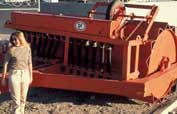 Early rolling imprinters, designed from 1976 to 1985, were massive machines having large-diameter rollers with complex patterns of imprinting teeth welded to their circumferences (Dixon & Simanton 1977). Imprinters designed after 1985 were smaller in diameter, lighter in weight, cheaper to fabricate, and easier to transport. They also had simpler and more efficient imprinting patterns. A drop seeder was mounted above the imprinting roller so that the seeder agitator could be directly driven by the tips of the imprinting teeth. The seeder is designed to dispense the morphologically diverse seed mixes commonly used in ecological restoration (Dixon & Carr 1991). It can also inoculate the soil with beneficial organisms such as cryptogams and mycorrhizae.
Early rolling imprinters, designed from 1976 to 1985, were massive machines having large-diameter rollers with complex patterns of imprinting teeth welded to their circumferences (Dixon & Simanton 1977). Imprinters designed after 1985 were smaller in diameter, lighter in weight, cheaper to fabricate, and easier to transport. They also had simpler and more efficient imprinting patterns. A drop seeder was mounted above the imprinting roller so that the seeder agitator could be directly driven by the tips of the imprinting teeth. The seeder is designed to dispense the morphologically diverse seed mixes commonly used in ecological restoration (Dixon & Carr 1991). It can also inoculate the soil with beneficial organisms such as cryptogams and mycorrhizae.
The AEI Concept for wide-range control of infiltration gradually evolved into the AEI Model for reversing global land desertification through imprintation and revegetation (Dixon 1983 & 1988, Dixon & Carr 1994a & 1994b). This model verbally and diagrammatically describes the four interrelated and interacting processes: Desertification, Infiltration, Imprintation and Revegetation (Figure 2). Desertification smooths and seals the normally rough-open interface, thereby greatly decreasing infiltration with resultant increases in water runoff, erosion, flash flooding, and sedimentation. Imprintation efficiently converts the smooth sealed desertified AEI back into the rough open condition, thereby restoring infiltration to high levels. Imprints greatly accelerate the revegetation process by funneling and concentrating resources to, in turn, germinate seeds and establish seedlings. Seedling establishment is enhanced by the favorable microclimate created by imprints. The AEI model can help develop and guide the cultural practices for sustainable agriculture, agroforestry, and ecological restoration of non-agricultural land areas. Imprinter seeding has already restored perennial grasses on 20,000 hectares of degraded land in the Sonoran Desert of southern Arizona and is currently being used to restore native vegetation at several degraded land sites in the Mojave Desert of southern California where annual precipitation is only about one-half that of the Sonoran Desert (Dixon & Carr, 1994c).
SUMMARY AND CONCLUSIONS
The series of studies described briefly herein were directed to making severely desertified land productive again through greatly improved rainwater infiltration control at the soil surface. Spatiotemeral scales were realistic. Sprinkling and closed-top infiltrometer frames were one-meter square and runs were one to two hours in duration. Before being eliminated by grazing cattle, the stands of perennial grasses in the Sonoran and Chihuahuan Deserts probably ranged from about one to 10 plants per square meter depending on annual precipitation. Microwatersheds created by the improved rolling imprinters are about 30-cm square. Thus nine of these tiny watersheds can fit inside a one-meter-square infiltrometer or plant sampling frame.
Geometrically, imprinted watersheds are V-shaped, right angle troughs with ends closed and with a small wing at the top. Each of these closed-basin microwatersheds can hold from 3 to 5 liters of rainwater, thereby extending the infiltration period following intense rainfall. These microcatchments are stabilized by the soil firming action of imprinting. While shaping the microwatersheds, imprinting increases the area of a flat desertified surface by about 30%.
Watershedding and infiltrating are at the microscale level to meet the needs of individual plants. Conventional seeding implements (drills and planters) leave continuous furrows which tend to bleed resources downslope instead of holding them in place to meet the needs of each and every plant beginning with seed germination and seedling establishment. Thus, the long-held dream of holding soil and water resources in place to grow crops, restore natural ecosystems, and rebuild topsoil has to a great extent been realized by these 30-cm square imprinted watersheds. Although the initial applications of imprinting have been in the drylands, this technology may also be appropriate for more humid regions, especially on sloping lands and hillsides where better infiltration control is especially critical.
The AEI Model represents a problem-solution strategy for restoring endangered natural ecosystems and degraded agricultural cropping systems. It identifies the general problem to be desertification and the resultant low rainwater infiltration rates. It pinpoints the cause of low infiltration to be loss of roughness and openness (microroughness and macroporosity) of the soil surface. The first step in solving the desertification problem then, is to restore roughness and openness, thereby accelerating infiltration. A new no-till process and several new machines–imprintation and imprinters–were developed to restore these two physical surface properties in the most cost-effective way possible. Then, the solution to restoring desertified ecosystems logically becomes imprinter seeding–a new no-till practice that greatly accelerates the revegetation process.
The AEI Model (Figure 2) provides a low-cost workable strategy for restoring vast areas of desertified land. Its use has already been proven in the Sonoran Desert of southern Arizona where tens of thousands of hectares of land, desertified by overgrazing and urban/industrial development, have been restored during the past decade.
Scientific models take many forms, but always represent greatly simplified versions of the real world. They are only as good as they are useful. They border on fantasy until applied to real world situations. Walt Whitman stated that: Theory without fact is fantasy and fact without theory is chaos.
It is the purpose of science to undergird theory with facts and unify facts with theory. The AEI Model does both. It unifies the many facts found in books on climatology, hydrology, edaphology, biology and ecology into a simple easily understood model. And its widespread success in revegetation and ecological restoration under diverse field conditions provides an abundance of supporting evidence.
The AEI model, although a gross simplification of the real world, is much too complex to be described mathematically, however its infiltration component is described adequately by Kostiakov’s equation (Dixon et al. 1978). In conclusion, the Air-Earth Interface Model is proving to be a useful tool for guiding ecosystem restoration and maintenance. More refinement of the model is expected along with the equipment used in its application. Equipment for imprinting steep slopes and hillsides is currently being developed. Also improvement in seed mixes and soil inoculation with mycorrhizae and cryptogams will almost certainly help to accelerate natural plant succession in ecological restoration projects.
REFERENCES
Dixon, R.M. 1966. Water infiltration responses to soil management practices. Ph.D. Thesis . University of Wisconsin, Madison. 175p.
Dixon, R.M. 1975. Design and use of closed-top infiltrometers. Soil Sci. Soc. Am. Proc. 39: 755-763.
Dixon, R.M. 1977. Air-earth interface concept for wide-range control of infiltration. Am. Soc. Agric. Engin .Paper No. 70-2062, 33p.
Dixon, R.M. 1980. Land Imprinter. U.S. Patent No. 4185655 . U.S. Patent Office, Washington D.C.
Dixon, R.M. 1983. Land imprinting for controlling infiltration and desertification processes. Am. Soc. Agric. Engin . Paper No. 83-2514, 15p.
Dixon, R.M. 1988. The air-earth interface model: Surface microroughness and macroporosity. Agronomy Abstracts . Am. Soc. Agron. p. 274.
Dixon, R.M. 1990. Land imprinting for dryland revegetation and restoration. In: Environmental Restoration: Sciences and Strategies for Restoring the Earth, Edited by John J. Berger. Island Press, Washington, D.C.
Dixon, R.M. & A.B. Carr 1991. Designing land imprinters for ecological restoration. In: Agronomy Abstracts . Am. Soc. Agron., Madison, WI. p.329.
Dixon, R.M. & A.B. Carr 1994a. Land desertification and revegetation: The air-earth interface model. Proc. 4th Int. Conference on Desert Development , p. 589-595. Int. Desert Development Commission, Colegio de Postgraduados en Ciencias Agricolas, and Comision Nacional de Zonas Aridas. 25-30 July 1993, Mexico City, Mexico.
Dixon, R.M. & A.B. Carr 1994b. Imprinting technology for restoring vegetation on dedgraded drylands. Transactions of 15th World Congress of Soil Science . Vol 7b: Commission VI p.274-275. Int. Soc. Soil Sci. and Mexican Soc. Soil Sci. 10-16 July, Acapulco, Mexico.
Dixon, R.M. & A.B. Carr 1994c. Land imprinting for low cost revegetation. Erosion Control 1(3): 38-43.
Dixon, R.M. & D.R. Linden 1972. Soil air pressure and water infiltration under border irrigation. Soil Sci. Soc . Amer. Proc. 36:948-953.
Dixon, R.M. & A.E. Peterson 1971. Water infiltration control: A channel system concept. Soil Sci. Soc. Am. Proc . 35:968-973.
Dixon, R.M. & J.R. Simanton 1977. A land imprinter for revegetation of barren land areas through infiltration control. Arizona-Nevada Acad. Sci. and Am. Water Resources Assoc . 7: 79-88.
Dixon, R.M. J.R. Simanton & L.J. Lane 1978. Simple time-power functions for rainwater infiltration and runoff. Arizona-Nevada Acad. Sci. and Am. Water Resources Assoc . 8: 79-89.
Dregne, H.E. 1978. Desertification: Man’s abuse of the land. J. Soil & Water Cons . 33: 11-14.
Dregne, H.E. 1994. Desertification: A framework for action. In: Abstracts, Int. Sym. Workshop on Desertification in Developed Countries: Why Can’t We Control It ? U.S. Bureau of Land Management and U.S. Environmental Protection Agency, 24-29 October, Tucson, Arizona.
Earth Action Staff 1994. Editorial advisories on desertification. Earth Action Network . Amhearst, MA. March and October, 4p.
Knickerbocker, B. 1994. Environmental wear in dry-land areas. Christian Science Monitor , p. 14, 25 October.
Linden D.R. & R.M. Dixon 1976. Soil air pressure effects on route and rate of infiltration. Soil Sci. Soc. Am. J. 40:963-965.
Lowdermilk, W.C. 1935. Man made deserts. Pacific Affairs 8(4): 409-419.
Philip, J.R. 1957. The theory of infiltration: 4. Sorptivity and algebraic infiltration equations. Soil Sci. 84: 257-265.
Sheridan, D. 1981. Desertification of the United States. Council on Env. Quality . U.S. Government Printing Office. Washington, D.C. 142p.
Whitford, W.G. 1994. Persistence of desertified ecosystems: Explanations and implications. In:
Abstracts, Int. Sym. and Workshop on Desertification in Developed Countries: Why Can’t We Control It? U.S. Bureau of Land Management and U.S. Environmental Protection Agency, 24-29 October, Tucson, Arizona.
Wolf, E.C. 1987. On the brink of extinction: Conserving the diversity of life. Worldwatch Institute, Paper 78, 54p.
UNEP 1992. Earth Summit: Convention on Desertification. United Nations Conference on Environment and Development . Rio de Janerio, Brazil, 3-14 June. 44p.

